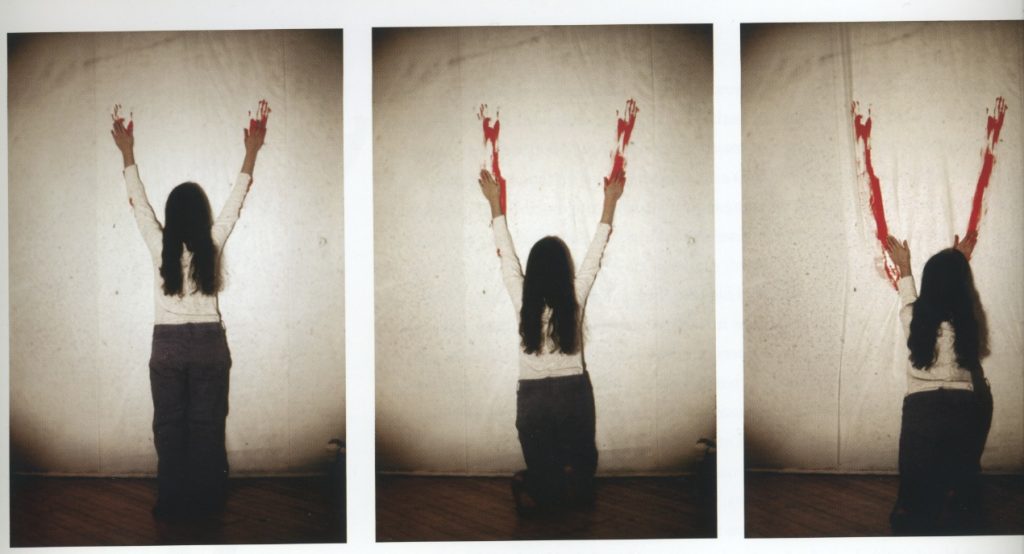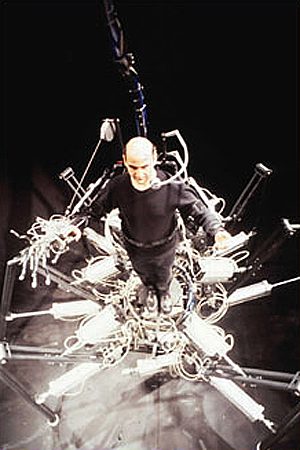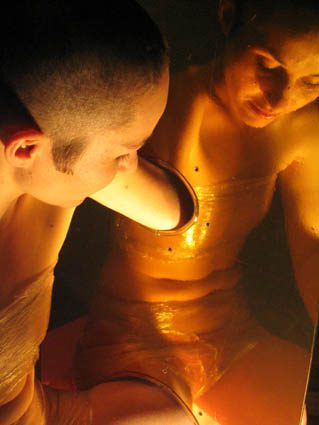Abstract
The narratives of the human body have developed throughout history, running parallel to various cultural paradigms. The implications of new media and digital technologies on the narratives of the 21st century body are currently under contentious debate. German new media theorist Friedrich Kittler disagrees with Marshall McLuhan’s proposal of media as an “extension of man” and contends that technology and the digitization of media marks an end to all aesthetic experiences. More radically, techno-humanists consider the body as an unnecessary limitation in the evolution of the human being and explore new technologies to liberate the human mind from the limitations of the physical body. Katherine Hayles, author of “How We Became Posthuman: Virtual Bodies in Cybernetics, Literature, and Informatics,” is one of the leading thinkers of the posthuman movement and argues that the physiological experience of “embodiment” and the abstract concept of “body” reside on a continuum of relational interactions, arising from dynamic fluctuating aspects of biology, culture, evolution and technology. Underlying all of these theories is a paradigmatic view that the physical human body is bound with complex beliefs about representations of the self. Referring to Jacques Lacan’s theories of sense of self and subjectivity, as well as Maurice Merleau-Ponty’s ideas of embodiment, Amelia Jones proposes a phenomenological approach to the narrative of the human body in new media. Here I explore Jones’s theory of “televisuality”,” supported by Mark Hansen’s theory of the body as “frame”, in relation to the aforementioned concepts of embodiment in the digital era. The theoretical discussion herein will be illustrated through historical developments in performance art and video art, exploring topics of subjectivity, perception, and embodiment.
Performance Art
Performance art of the 20th century evolved from the studies of motion, performativity and simultaneity of the early avant-garde to become one of the most prominent forms of postmodern expression. In the 1960’s and 1970’s the artist’s body was used as raw material in performance actions as a means of inscribing cultural and political meaning on the performative subject. The use of the artist’s body as a means of direct expression was an attempt to deal with modernism’s assumption that fixed meanings are determined through formal structures of the work and the refusal by modernism to acknowledge that all cultural practices are embedded in society. The body, which previously had been veiled to confirm the modernist regime of meaning and value, more and more aggressively surfaced during the 1960’s as a locus of the self and the site where the public domain meets the private, where the social is negotiated, produced and made sense of (Warr, 2000). According to Amelia Jones, Professor and Pilkington Chair in Art History and Visual Studies at the University of Manchester, the incorporation of the messages of cultural meaning onto the artists’ own bodies reflects the transition from a modernist body that was struggling with the Cartesian body/mind dualism to a postmodern body that is defined through intersubjective exchange (Jones, 1998). This period of performance art, referred to by Wegenstein as the“1960’s wounds”, was characterized by self-mutilation, masochistic actions, and the confrontation of the abject (Wegenstein, 2006). Performance art of the 1960s was a crucial moment in embodiment of aesthetics, introducing a form of artistic practice in which the artist’s body could be used both as material and expressive language. All bodily manifestations of performance art in the 1960’s staged the body in time and space that disclosed itself not so much as matter than as a materialization necessarily mediated by the contexts in which it is lived, located, perceived, acted out and acted upon (Ross, 2006).

The Body in a Technological Reality
There was a distinct shift from an emphasis on the body as raw material in the 1960’s to an emphasis on media, media technologies and their impact on the body as well as its interpretation, in the performance art of the 1990’s. Wegenstein labels the works of this period “1990 extensions”, referring to the shift from concern with the body in social context to the reality of the body in a technological one (Wegenstein, 2006). Such performance works, according to Amelia Jones, “acknowledge the deep implications of the politics of representation in relation to the embodied subject,” (Jones, 1999, p. 3). In these hypermediated extensions of the body the self is no longer explored primarily in relation to culture and context but through new possibilities of the technologies of the body, particularly those enhanced by new media. The remediation of the pre-digital performative body into the limitless potential of the digital realm brings to question concepts of subjectivity, embodiment, body image and the sense of self. Performance and new media artist Valie Export agrees with the notion that real bodies and their proof of authenticity in the 1960s has been replaced by a cyber-logic that is inspired by a paradigm of techno-body space. Cyberspace uses imaginary bodies, provoking a dialog between technology and the body, leading to expansive inter-medial art forms. The result is a hybrid aesthetic, combining body actions of 1960’s performance art with digital compositing and remediation, embodied on electronic monitors (Mueller, 1994). With this comes a change in the concept of subjectivity (Wegenstein, 2006).

Friedrich Kittler, professor at the Institute for Aesthetics at Humboldt University in Berlin is one of Germany’s preeminent literary critics and media theorists. Kittler predicts the result of technophenomenon will result in a loss of the body and its extensions. Kittler sees digital remediation as the end of media, collapsing individual disciplines into pure computational data, in turn destroying our aesthetics, self-image and identity. Kittler argues the digital image not only collapses the time-based aspects of embodiment into a synchronic, virtual dimension, it also strips aesthetics of any intrinsic correlation with human perceptual experience. Aesthetics become purely arbitrary based on computational processing, a reflection of technical innovations and limitations rather than artistic inspiration (Johnston, 1997).
The Obsolete Body
Techno-human theorists take a different approach to the relationship of the body and technology (Wegenstein, 2006). Australian techno-human artist Stelarc considers human beings to have always been machines, made up of nothing else but information. In his prosthetic and robotic experiments, Stelarc explores the human-machine interface within the context of techno-humanism. Stelarc embraces new technologies as an escape from the evolutionary inefficiencies and frailties of the human body. Stelarc views the body as a limitation and approaches mutation, prosthetics and symbiotic incorporation of technology into the body as necessary for evolutionary progress (Bell, 2000).

Phenomenology
In contrast to theorists who focus on digital media as marking the obsolescence of the body, a phenomenological approach to new media posits the body as becoming increasingly necessary for its role in mediating the digital image. French phenomenologist Henri Bergson developed the concept of the body image as mediator of perception. Similar to psychoanalysis, phenomenology tries to separate the subject of the body (the world as perceived through one’s body) from the objectified body (the body as it is perceived by the world), a distinction between the subject of perception and the socially constructed body (Wegenstein, 2006). For Bergson, the body image is composed of two distinctive and somewhat paradoxically interrelated dynamics. On the one hand, the body image is the way in which a person perceives his or her own body, a necessary intermediary between the self and the unknowable outside reality. The other side of the interrelated body image indicates that the body itself is the perceptive apparatus through which the world is being processed. This means that the image is itself produced by the body, the intermediary source of all images. The body is at the same time “mirror” or “screen” for the images from the outside and the perceptive center; the body is “what takes shape at the center of perception” (Wegenstein, 2006, p. 29).

Body as Framer
Mark Hansen adopts a phenomenological perspective to the digital, post-medium condition, emphasizing the role of the affective, proprioceptive and tactile dimensions of the body in relation to digitized visual media. For Hansen, vision is shaped in terms of visceral bodily elements rather than by the abstract power of sight. Any objective qualities of an image are filtered through the eyes, which are an organ of a more complex body apparatus that is the center of where all sensory information is processed. Hansen maintains that the body continues to be an active “framer” of the image even in a digital world. Digitization allows for an almost limitless potential to modify any image, and to modify the image in ways that disjoin it from any fixed technical frame. Thus, the digital image requires the body as that “place” where the self-differing of media gets concretized. For a theory of art in the specifically “post-medium” condition created by digital technology, the body itself is invested with the responsibility of framing or filtering the fluctuating, floating, images (Hansen, 2004).
Relational Perspective
Katherine Hayles, author of “How We Became Posthuman: Virtual Bodies in Cybernetics, Literature and Informatics”, supports Hansen’s thesis by positing a relational approach to the concepts of body and embodiment. In her article “Flesh and Metal: Reconfiguring the Mindbody in Virtual Environments”, written as a follow-up to “How We Became Post Human”, Hayles focuses on the idea of a relational approach to the concepts of body and embodiment. A relational perspective posits embodied experience as not only stemming from complex interplay between brain and viscera. Rather, embodied experience comes from the constant engagement of our embodied interactions with the environment. Images of the body emerge from a combination of cultural formations and beliefs. In this view embodiment and the body are emergent phenomena that arise from a dynamic flux. Hayles uses Mark Hansen’s term “mindbody” to signify the emergent quality of the body and embodiment (Hayles, 1999).
Televisual Body
Amelia Jones’s phenomenological approach to performance art further articulates a presence of the body that is always deployed both as “object” and “subject”, as dependent and contingent on the other for its formation and actualization (Ross, 2006). Expanding on Katherine Hayles’ concept of a non-oppositional relationship between body image and embodiment, Jones views the “technophenomenological body/self as fully mediated through the vicissitudes of bio- and communications technologies, and fully engaged with the social. The body/self is hymenal, reversible, simultaneously both subject and object,” (Wegenstein, 2006, p. 67). Jones explores new media, specifically televisual bodies, for their capacity to activate rather than suppress the object or subject reproduced. The insistence on embodiment and the potential of the televisual screen to open out and enhance complex relations of intersubjective engagement supports Jones’s argument which addresses the way in which artists have explored, flaunted and otherwise called into question the concept of “otherness” through representations of flesh on or more accurately as televisual screens. By televisual, Jones is referring to any work that exploits the intimate texture of the video, television or computer monitor to convey aspects of embodiment. Jones stresses that the viewer and the subject within the televisual image are potentially activated in a complex psychodynamic relation to each other (Jones, 2006).
The Screen
Jacques Lacan articulated the psychodynamic notion of “screen” in his 1964 essay “What Is a Picture”. Lacan offers an understanding of subjectification in relation to the screen, which is the site where two subjects reciprocally define and negotiate one another in the visible. It is the screen where the gaze meets the subject of representation, the locus of mediation where the human subject “maps himself in the imaginary capture” of the gaze. The subject is always already “imaged” in the purview of the gaze and is always thus both subject and object of a kind of looking. The image in general is itself a “screen”, the site where subject and objects, self and other, intertwine to produce intersubjective meaning (Jones, 2006). This relates to Lacans “mirror stage” of psychological development where the construction of identity goes hand in hand with the perception of the bodily self through a deceptive image that is either framed through somebody else’s gaze (the mother) or through the frame of a medium (the screen). With its emphasis on mediation it is a necessary and logical consequence that new media will be highly invested in questions of identity and constructivism and as a result in the role of the frame which, as Mark Hansen explains, is missing in the digital realm (Wegenstein, 2006). The screen is the surface of mediation, much like the skin of the physical body, marking intersubjectivity and identification as complex processes that depend on a sense of being seen or otherwise experienced as “other” (Bowen, 2006).
In the projection of our self image that constitutes our enactment of what we call our “individuality”, the subject, according to Lacan, “gives of himself, or receives from the “other”, something that is like a mask, a double, an envelope, a thrown-off-skin” – the screen (Lacan, 1964). In Lacan’s theory, the subject conveys oneself to the work via a “thrown-off skin” or a screen; the fully dimensional flesh of the subject is thus reduced to a limp husk, an empty shell, pointing to but not sustaining embodiment. For Merleau-Ponty, subjectivity is achieved by relating to the world through a vision that is resolutely embodied and open to the “flesh of the visible”. The embodied subject is thus “a being of depths” but also “a presentation of a certain absence” whose flesh both directs the person into the world as a seeing subject but also consigned to being seen: “the body is at once phenomenal body (sentient body) and objective body (sensible body), “ (Merleau-Ponty, 1968, p. 135).
Video Screen as “Skin”
Jones’s argument of a phenomenological theory of new media rests with her interpretation of the skin of the video screen as a surface that is not simply a two-dimensional electronic interface, but containing implications of a new kind of embodiment particular to the post 1960’s era. French media philosopher Jean Baudrillard (1983) raises alarm over the ramifications of replacing an intersubjective mirror and stage with the electronic screen:
Today the scene and the mirror no longer exist; instead, there is a screen and network. In place of the reflexive transcendence of mirror and scene, there is a nonreflecting surface, an immanent surface where operations unfold – the smooth operational surface of communication. The simple presence of the television changes the rest of the habitat into a kind of archaic envelope, a vestige of human relations whose very survival remains perplexing. The real itself appears as a large useless body (p. 127).
While Baudrillard suggests a complete replacement of the stage with digital television, Jones takes a less oppositional approach, viewing the televisual as a continuation of certain aspects of performance. While Jones explores the ontological differences in production and reception, she also stresses similarities between performance art and video art in the portrayal of a new body narrative.

Jones claims allegiance with Katherine Hayles who states that bodies “can never be made of information alone, no matter which side of the screen they are on” (Jones, 2006). Jones explores new media, or televisual bodies, for their capacity to activate rather than suppress the “object” or “subject” reproduced. Jones often refers to Swiss performance and video artist Pipilotti Rist as emblematic of the new narrative of the body on the televisual stage. Rist’s discussion of her work summarizes the psychodynamic and cultural significance of a new media, televisual narrative of the body.
In my experiments with video it becomes clear to me how very much these supposedly faulty, chance images are like the pictures in my own subconscious. I call these pictures, which don’t match up with the dictates of the ‘good’, average images of the subconscious of the video machine. These ‘poor’ pictures are related to those that shoot out from some unknown place when I’m looking at reality; they muddle with what I’m seeing. They are like the pictures in your head when you’re falling asleep, when you close your eyes tight or when you’re dreaming, either by day or by night. It’s as though my own subconscious had materialized in the subconscious of the machine. The faulty images reveal what is otherwise concealed. These are the pictures that the industry technicians are so horrified by, those that they simply ignore. But there are lots of other people working with botched material. By doing so we pay homage – behind our ordinary machines, found all over the world by now – to the dead inventors who created these tools. Making videos, whether experimental or poetic, means doing family therapy; the television is a family member, so to speak. If my work is intense, honest and good, then its therapeutic function is also my social relevance. Do you believe in antenatal conditioning? (Phelan, 2001, p. 108).
For Pipilotti Rist, the televisual screen is flesh in the sense articulated by Maurice Merleau-Ponty: flesh as substance of the world, substantiating our bodies as human. Rist’s manipulated video imagery adds an entirely new psychological and emotional dimension to video technology and its relationship to embodiment. Giving the screen flesh, as it were, she points to the continuum between body and machine image, between the eye and the apparatus; there is no “real” body to which we need to return, for the image screen is flesh. Rist associates video’s capacity to function as a kind of externalized psychosomatic rendering to its quality as screen image. The screen of the televisual image can operate as a kind of corporealizing hole, an opening back into the three-dimensionality of lived flesh thought to have been left behind by the very act of digital reproductive image-making, (Jones, 2006).
Paul McCarthy’s video art work Press (1972 and 1974) is another example of a performative, embodied approach to the televisual image. McCarthy’s description of the piece brings emphasis to the relationship between his body and the television screen. “I pressed my face and upper torso against a sheet of glass with saliva acting as a lubricant against the glass – when viewing the tape, I appear to be inside the monitor, pressing against the screen,” (McCarthy, 1996, p. 39). With his face pressed against the glass, his flesh appears to be pressing against the inside of the televisual monitor. While the screen separates McCarthy from the viewer, the apparent shared surface of the monitor and McCarthy’s flesh embodies him as an aspect of the viewers’ space. Press produced McCarthy as a function of videographic representation, as a body produced through and apparently coextensive with a screen, which took on three-dimensionality as a kind of body. Analyzing the subjective impact of this sort of new media work, Jones argues that what is specific to the televisual screen, as manipulated by visual artists, is its capacity to convey embodied subjects in a manner that potentially transforms the viewers sense that the bodies on the screen are “other”. Such works evoke “haptic opticality”, a kind of tactile, synaesthetic seeing. Dore Bowen terms the shift from “lived experience” of performance art in the 1960’s to the televisual embodiment of new media “digital liquefaction”:
The spectacle has metastasized. No longer defined entirely by the dialectic of alienation/lived experience it is marked by its apparitional flow that operates in and around the index, the local, and the focal, thus producing forms that are an amalgamation of analogue and digital or that reflect on the analogue through digital means. This characteristic is what I call “digital liquefaction”. The relationship between the image and the viewer’s subjective experience no longer appears to be oppositional; rather, the mutability struggled for by an earlier generation of artists emerges as the condition of the image (Bowen, 2006, p. 544).
Jones proposes that artists such as Rist and McCarthy perform their embodiment as resolutely technologized but in such a way that the televisual screen is embodied while their flesh takes its texture and materiality from that of the televisual monitor (Jones, 2006). Artists who interact with the screen as an extension of their bodies invite relations of projection and identification that can produce a new kind of viewing subject, one that is dependant on the viewer’s experience of intersubjectivity with the televisual image. This sets in motion the psychosomatic dynamics of a new body narrative, specifically unique to the televisual space.
References
Bell, David (2000). The Cybercultures Reader, A User’s Guide, London, Routledge.
Bowen, Dore (2006). Imagine There’s No Image (It’s Easy If You Try: Appropriation in the Age of Digital Reproduction. In Amelia Jones (Ed.), A Companion to Contemporary Art Since 1945, (pp. 534-556) MA: Blackwell Publishing.
Grosz, Elizabeth (1995). Psychoanalysis and the Imaginary Body. In Penny Florence and Dee Reynolds (Eds.), Feminist Subjects, Multimedia: Cultural Methodologies, (pp. 183-190) Manchester: Manchester University Press.
Hansen, Mark (2004). New Philosophy for New Media, MA: The MIT Press.
Hayles, N. Katherine (1999). How We Became Posthuman, Virtual Bodies in Cybernetics, Literature, and Informatics, Chicago: The University of Chicago Press.
Hayles, N. Katherine, Flesh and Metal: Reconfiguring the Mindbody in Virtual Environments, HYPERLINK “http://www.medienkunstnetz.de/source-text/116/” http://www.medienkunstnetz.de/source-text/116/
Johnston, John (Ed.). (1997). Friedrich A. Kittler Essays, Literature Media Information Systems, Amsterdam: G+B Arts International.
Jones, Amelia (1998). Body Art, Performing the Subject. Minneapolis: Regents of the University of Minnesota.
Jones, Amelia (2006). Self/Image: Technology, Representation and the Contemporary Subject, New York: Routledge.
Jones, Amelia & Stephenson, Andrew (Eds.). (1999). Performing the Body/Performing the Text. London: Routledge.
Lacan, Jacques (1986). What Is a Picture? The Four Fundamental Concepts of Psycho-Analysis. (Alan Sheridan, Trans.) New York: Norton.
McCarthy, Paul (1996). Paul McCarthy, London: Phaidon.
Maurice Merleau-Ponty, “The Intertwining – The Chiasm, “ Visible and the Invisible (1964) trans. Alphonso Lingis, ed. Claude Lefort (Evanston, IL: Northwestern University Press, 1968), 135.
Phelan, P., Obrist, H. U. & Bronfen, E. (Eds.). (2002). Pipilotti Rist. London, Phaidon Press Limited.
Ross, Christine (2006). The Paradoxical Bodies of Contemporary Art. In Amelia Jones (Ed.), A Companion to Contemporary Art Since 1945, (pp. 378-400) MA: Blackwell Publishing.
Warr, Tracey & Jones, Amelia (2006). The Artist’s Body, London: Phaidon Press Limited.
Wegenstein, Bernadette (2006). Getting Under The Skin: The Body and Media Theory, Massachusetts: The MIT Press.
Weiss, Gail (1999). Body Images: Embodiment As Intercorporeality, London: Routledge.
Televisual Body PAGE 14



